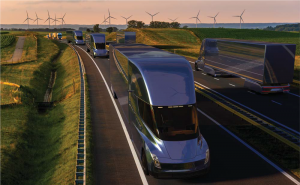 Electric trucks provide an opportunity for organizations with fleets to fundamentally transform the environmental impact of their operations. But rather than the incremental progress of better pollution control equipment and improved fuel efficiency we’ve seen play out over the past two decades, the technical innovation in electric vehicles over the past few years has been brisk.
Electric trucks provide an opportunity for organizations with fleets to fundamentally transform the environmental impact of their operations. But rather than the incremental progress of better pollution control equipment and improved fuel efficiency we’ve seen play out over the past two decades, the technical innovation in electric vehicles over the past few years has been brisk.
For example, recent EDF analysis demonstrates that well over 125 fleets are either running zero-emission trucks today or have them on order. Manufacturers, meanwhile, are investing billions in the technology and bringing new models to the market at a breathtaking pace.
The rapidity of change in this space can make it challenging for fleets to calibrate their ambition. And yet, the current decade is critical to put the medium and heavy-duty vehicle sector on a path toward a clean energy future. Here are four actions fleets must take to be sustainability leaders today:
1. Commit to becoming a zero-emission fleet
Companies need to set clear, time-bound goals for completing their transition to a zero-emission fleet. Public, ambitious goals have long been a hallmark of leadership on sustainability. Goals have a unique ability to focus and align internal efforts. Fleet goals should embrace the singular end-point: a full transition to zero-emission vehicles. The unique attributes of the fleet, such as vehicle types, duty cycles and length of turnover cycles will influence the end year of the commitment.
4 actions fleets must take to be sustainability leaders today Share on X2. Share a transition plan with clear milestones and that prioritizes community health
Companies should share high-level details of their plan to achieve a zero-emission goal. This could include milestones that indicate which components of their fleet that can be more quickly transitioned as well as targets for adoption levels over the course of the commitment. Companies should have specific milestones to address the near-term health impacts operations have on communities that have been historically overburdened with diesel pollution.
3. Deploy zero-emission solutions today and share learnings and key challenges
Getting hands-on experience is the best way to understand the opportunities and challenges around deploying zero-emission vehicles. This information will inform a company’s fleet transition plan and help accelerate adoption. It will also help fleets recognize the new best practices and technical solutions that will unlock deployment for the next segment of their fleet. Sharing these learnings with other fleets will further expand a fleet’s understanding and build the production scale necessary to continue driving down costs of vehicles and other equipment.
4. Engage with policymakers in support of emission standards, societal investments and other measures needed to accelerate the transition to zero-emission fleets
No one company can scale up a zero-emission fleet on its own. Companies need to use the most powerful tool they have to fight climate change: their political influence. Opportunities to use this leverage include utility programs to develop charging infrastructure, government research investments and support for accelerating the introduction of ZEVs; and state programs that create incentives for using ZEVs.
Organizations with large fleets must meet this dynamic landscape with decisive leadership. The fleet industry can and must transition to zero-emission solutions. This transition will deliver massive benefits for human health, our environmental and the economy. Fleet action, though, will drive how quickly this transition occurs. By taking these four actions, fleets can put us in the fast lane to a better future.









